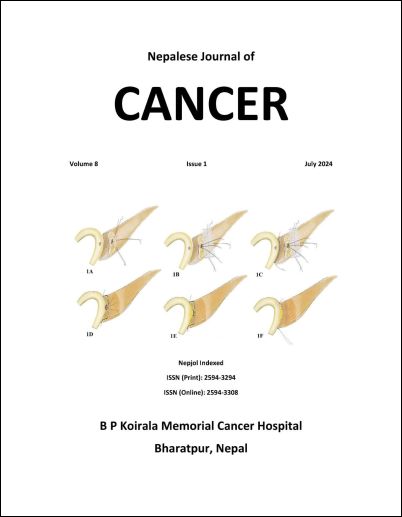Outcomes of Laparoscopic Partial Nephrectomy for small renal masses
DOI:
https://doi.org/10.3126/njc.v8i1.69140Keywords:
Renal cell carcinoma, Postoperative complication, Small renal masses, Laparoscopic partial nephrectomyAbstract
Background: Due to the increased use of imaging modalities in daily medical practices, more and more small renal masses are detected. For these SRMs, nephron sparing procedures are more commonly opted rather than radical nephrectomy for the sake of preservation of renal function and proven similar oncological outcomes. This surgery has evolved from open, laparoscopic to Robot-assisted approaches. This article summarizes our institutional experience of laparoscopic partial nephrectomy.
Materials and Methods: Patients with small renal masses who underwent laparoscopic partial nephrectomy at B.P. Koirala Memorial Cancer Hospital from January 2023 to June 2024 were retrospectively retrieved. Altogether 23 case notes fulfilled the criteria for analysis. All the demographic, preoperative, intraoperative, postoperative data were collected form the notes and plotted. All the issues within 30 days of surgery were defined as early complications. Clavein-Dindo Classification used for analysis. SPSS 25 software was used.
Results: Twenty three patients underwent partial nephrectomy with lapascopic method. All were done trans-peritoneally. Average age of patient was 50.96±12.8 years with range of 33-76. Male were 14 and 9 were females. Average hospital stay was 8 days. The majority of patients after PN recovered well. Nonetheless, 8 developed postoperative complications. GI complications were 8.7%, infections related 13%, Wound related 8.7% and others. Two patients (8.3%) were required to undergo reoperation and nephrectomy for haematuria.
Conclusion: Laparoscopic partial nephrectomy is a surgery with steep learning curve. As it requires advanced laparoscopic suturing skills, complications in early period was common. After maturity the complications are as par to open PN.
Downloads
Downloads
Published
How to Cite
Issue
Section
License
Copyright (c) 2024 Nepalese Journal of Cancer

This work is licensed under a Creative Commons Attribution 4.0 International License.
This license lets others distribute, remix, tweak, and build upon your work, even commercially, as long as NJC and the authors are acknowledged.
Submission of the manuscript means that the authors agree to assign exclusive copyright to NJC. The aim of NJC is to increase the visibility and ease of use of open access scientific and scholarly articles thereby promoting their increased usage and impact.




